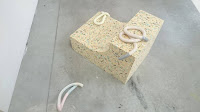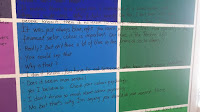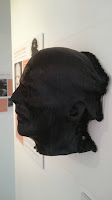 |
| My contribution to 'What we talk about...' |
Here it is, the final day of the event. Unfortunately, I
haven’t been as involved in it as with the first two days. I think my artistic
eye is beginning to tire. Nonetheless, I managed to attend one small exhibition
on Union Street: ‘What we talk about when we talk about love’ by MarcellaFinazzi at Sloggett and Son.
Walking in, it felt at first like any other antiquities
shop, however, further back it became more like a domestic living space crammed
with retro furnishings – a boar’s head on the wall, old bicycles, comfy chairs.
I would describe it as homely yet foreign chic. The idea behind it was to take
in the room and then write a note about what love means to you. My meaning was
along the lines of love being a place where you can go with the one who matters
to you – coincidental then, that a map of the Netherlands happened to be on the
wall, the very place I had visited on two occasions with my special someone.
 |
| Julian Isaacs: A man at one with his creative side |
I again had my companion Mark Jones with me today, and while
he was willing to explore whatever exhibition I chose, my heart wasn’t in it
anymore, and so we turned away from the simmering revelry of the Union Street
Party and re-entered the town centre. Along the way, we spotted local
performance poet Julian Isaacs strumming away on-stage, before passing what the
Arts Weekender leaflet termed ‘the smallest exhibition space in
Plymouth…probably’ in the window of The Zone – and it was pretty much just
that. Steve Clement-Large’s ‘Probably’ was a small collection of items in a
shop front which you could easily miss if you weren’t looking for it. I didn’t
examine it too closely though, so any significance between the title and its
components was lost on me. A further disappointment
was learning that Jo Beer’s
collection of works at the Theatre Royal entitled ‘Fleshy’ was not open to the
public until tomorrow. The glimpse I caught through the window though looked
promising so I may return. However, I did have one last event for the day:
‘Music of motions and presence’ at The House.
 |
| Spot the Exhibition: Steve Clement-Large |
It was quite honestly the most original, haunting, and
experimental piece of abstract music I had ever heard. The instruments seemed
to come alive under the musicians’ hands, sometimes, with the aid of motion
sensors, without even touching them. This was, of course, the aim: to create
sound using gestures and the musicians’ body movements. Marco Frattini
commanded a drum kit, a small set of acoustics, and an electronic drum pad,
from which escaped sounds unlike anything I’d ever heard from such instruments:
explosively metallic heartbeats, chaotic stampedes, and screams drawn out by
running a violin bow along the edge of a cymbal. Running solo was Lara Jones on
a saxophone, creating noises which ranged from the roar of a plane overhead to
the discordant trumpet of several stuck elephants, with a classic jazz tune in
between. To complete the trio was the most important figure of all: researcher,
composer and performer Federico Visi. His instruments of choice included
electronic drum pad, synth board, and guitar, the latter of which dominated my
attention. There was an almost organic quality to the noises he drew from it,
groaning, growling, lurking like a predator, at times giving me chills when he
drew a bow across its strings. All of this combined to create an ensemble full
of anxious energy, hints of the industrial classicism of steampunk, and ghostly
reverberations caused by the musicians’ movements. It was truly otherworldly to
watch Federico move his hands above his guitar and hear the notes being drawn
out, as if his own body had become an instrument or, as in the principle of The
Extended Mind, the instrument was part of him. I learnt in a short talk with
him after the show that these performances are a fairly even balance between
scored and improvisation so it’s not always clear what will happen next. To be
honest, I could’ve listened all night; there’s just something about the
distortion and uniqueness of such music that never ceases to amaze.
 |
| Calm before the Storm: 'Music of motions and presence' |
As, indeed, has this Plymouth Arts Weekender.
















